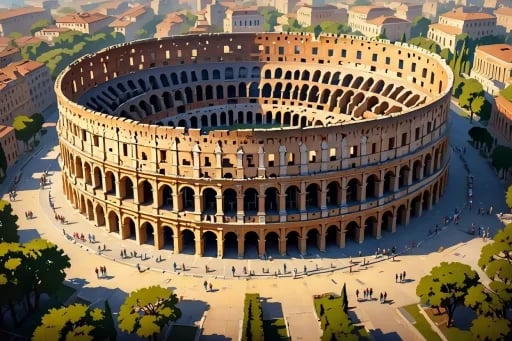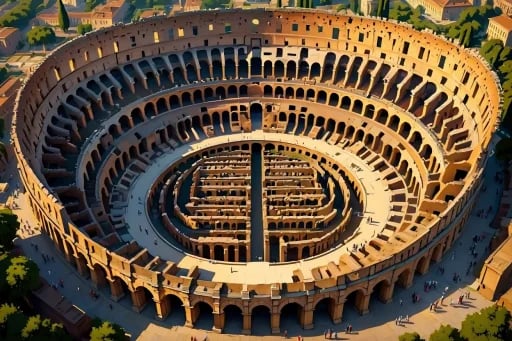The Colosseum: Gladiators, Ghosts, and Grit in the Eternal City
Nestled in the heart of Rome, Italy, the Colosseum (or Colosseo, if you want to impress the locals) isn't just another tick on your tourist bucket list-it’s the gloriously dramatic, blood-soaked, lion-roaring origin story of Western entertainment. It’s where stone meets spectacle, where emperors flexed and gladiators fought for glory-or at least a really enthusiastic thumbs-up.
EUROPEITALYROMEUNESCOARCHITECTUREHISTORYECHOES OF ELSEWHERE


Rome, Italy
Let’s be honest, the Colosseum is having a millennia-long main character moment. It’s the Beyoncé of ancient ruins. The world’s most famous broken circle. The architectural equivalent of a celebrity who's aged very gracefully, even after 2,000 years and a few metaphorical (and literal) earthquakes.
Nestled in the heart of Rome, Italy, the Colosseum (or Colosseo, if you want to impress the locals) isn't just another tick on your tourist bucket list, it’s the gloriously dramatic, blood-soaked, lion-roaring origin story of Western entertainment. It’s where stone meets spectacle, where emperors flexed and gladiators fought for glory... or at least a really enthusiastic thumbs-up.
Whether you're searching for “Colosseum tickets,” wondering “What to see at the Colosseum,” or having an existential crisis over “Is the Colosseum worth it?” (spoiler: yes), let’s dive into Rome’s most iconic arena and all the weird, wild, and wonderful things it has in store.
What Exactly Is the Colosseum?
Built in 80 A.D. by Emperor Vespasian and his very extra son Titus, the Colosseum was the ancient world's version of Netflix, the UFC, and Coachella rolled into one massive amphitheater. Back in its heyday, it could seat up to 80,000 people, most of whom were there to watch something die... usually in dramatic fashion, preferably with a tiger involved.
Spoiler alert: the name “Colosseum” comes not from its size (though it is indeed colossal), but from a colossal statue of Nero that used to stand nearby. Rome doesn’t do subtle. Never has.
How to Visit the Colosseum (Without Having a Public Meltdown)
Step 1: Book Tickets in Advance
Let’s be real. If you try to buy Colosseum tickets at the door, you’ll spend more time in line than Nero spent writing poetry. (A long time. He was very into poetry.)
Grab a skip-the-line Colosseum ticket, or better yet, book a guided Colosseum tour that includes access to the Colosseum underground and arena floor - because what’s the point of being here if you can’t stand dramatically in the center and yell “Are you not entertained?!”
Step 2: Combo It Like a Roman
Most tickets include entry to:
The Roman Forum (ancient gossip central),
And Palatine Hill (where the emperors lived in style).
It’s like a 3-for-1 time machine, and your sandals will thank you for walking it all in one go.
What to See at the Colosseum (Besides Your Own Reflection in Your Sunglasses)
Step inside and behold the layered arches, sun-drenched stone, and haunting grandeur of 2,000 years of history. This isn’t just a building, it’s a giant fossil of human drama.
Wander through:
The arena floor where gladiators once strutted like ancient WWE stars.
The hypogeum - a backstage labyrinth of trapdoors, cages, and tunnels. Think Broadway meets Jurassic Park.
The upper levels, where plebeians watched the action while sneakily judging everyone below.
If you're lucky, you might even catch a Colosseum night tour when the arena glows like it’s about to drop the hottest opera of the season. Goosebumps included.
Colosseum Fun Facts You Can Casually Drop Over Aperitivo
It was once flooded for mock naval battles. Yes, the Romans built a stadium and turned it into a pool. Overachievers.
Over 400,000 people and 1 million animals are estimated to have met their end here. Ancient Rome really took “go big or go home” to the extreme.
It’s the largest ancient amphitheater still standing in the world, and probably the only one where your phone signal mysteriously drops right when you’re trying to post to Instagram. (Historic preservation or divine intervention? You decide.)
When to Visit the Colosseum (And When to Pretend You Did)
If you're Googling “best time to visit the Colosseum,” here’s the breakdown:
Early morning (before 9 AM): Fewer tourists, softer light, better photos, smug inner peace.
Late afternoon (after 4 PM): Golden hour glow. Everything looks like a postcard.
Avoid midday in summer: Unless you want to experience ancient Rome through the lens of sunstroke.
Pro tip: Spring (April–June) and Autumn (September–October) offer the perfect balance of pleasant weather and manageable crowds. July and August are peak sweat-and-tourist season... be brave or be burned.
What to Bring (Other Than Curiosity and a Comfortable Pair of Shoes)
Water bottle (there are fountains, and yes, the water is drinkable)
Sunscreen + hat (the sun is relentless and shade is a myth here)
Camera or phone (obviously)
Roman curiosity (because everything has a backstory)
And if you're into drama: a flowing scarf for that cinematic Colosseum twirl
Bonus: Download an audio guide app or podcast. Otherwise, you’ll be pointing at ruins saying “...maybe this was a bathroom?”
What Else is Nearby? (Also Known As: When in Rome…)
You’re standing in the literal center of ancient Rome. Around you: time travel on every corner.
Roman Forum – The political heart of the empire. Picture senators in sandals yelling at each other.
Palatine Hill – Where Romulus allegedly founded Rome. Also, excellent views of the city.
Arch of Constantine – Rome’s version of a victory lap.
Piazza Venezia – With that over-the-top white monument that looks like a wedding cake and a typewriter had a baby.
Within walking distance, you’ve also got Trevi Fountain, the Pantheon, and enough gelato shops to keep your blood sugar heroically elevated.
Common Questions, Uncommonly Answered
Is the Colosseum overrated?
Only if you hate history, architecture, and jaw-dropping ancient engineering. Otherwise, absolutely not.
How long should I spend there?
Minimum 1.5 to 2 hours. Longer if you’re a history buff or just really enjoy climbing uneven marble stairs.
Can you go inside the Colosseum?
Yes, and if you don’t, did you even go to Rome?
What about the gladiators?
Long gone. But you will see guys dressed like them outside charging €10 for a photo. Proceed with caution and small bills.
Final Curtain: A Love Letter to Rome’s Most Iconic Arena
In a city bursting with ruins, fountains, and more gelato flavors than you can say with confidence, the Colosseum still steals the show. It’s awe-inspiring, slightly ridiculous in scale, and unapologetically dramatic, just like Rome itself.
You don’t walk away from the Colosseum. You strut away. Sun on your face, dust on your shoes, history in your heart, and 87 photos in your camera roll that all look exactly the same but you’ll keep them forever.
Because no matter how many travel lists, books, or influencers try to describe it… standing inside the Colosseum is something else entirely.






